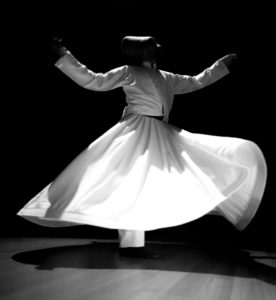The magical powers of movement fascinated Laban. Two anecdotes recounted in his autobiography highlight his keen interest – the first was observing a folk dance meant to make warriors immune to wounds; the second was witnessing Sufi rituals in which dancers actually stabbed themselves but the wounds closed immediately. Laban mused, “Belief in a magic that conquers nature was surely just foolishness, a childish superstition – but even so, wasn’t there something great, something immense hidden behind it?”

This reflection, or perhaps quest, is reflected in many of Laban’s theoretical writings, where he hints at the spiritual value and transcendental power of movement. For example, in Mastery of Movement Laban laments that “The European has lost the habit and capacity to pray with movement… The ritual movements of other races are much richer in range and expressiveness.”
Later, in this same book, Laban explains that “Living beings struggle with their surroundings, with material things, with other beings, and also with their own instincts, capacities and moods; but man has added to this the struggle for moral and spiritual values.” He adds, “The theatre is the forum wherein the striving within the world for human values is represented in art form.”
Is Laban doing for acting and dancing what Kandinsky did for painting in Concerning the Spiritual in Art? Find out more by joining other readers for a journey through Mastery of Movement, beginning in early March.
